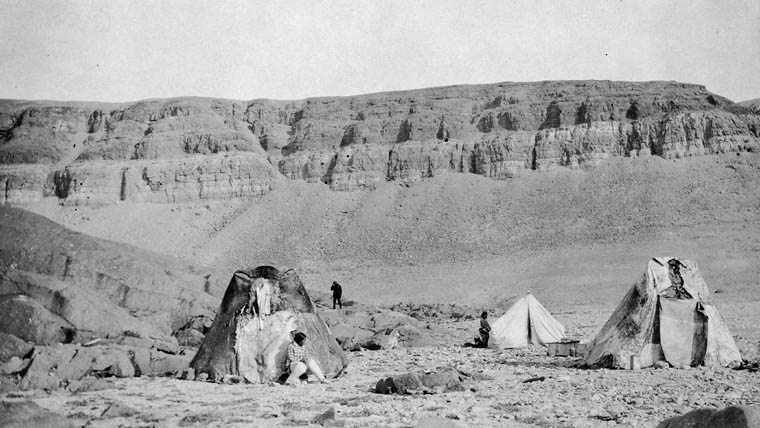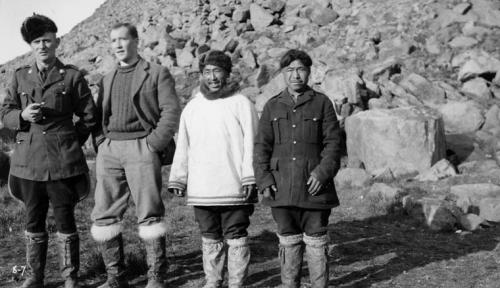RCMP
The RCMP would play an important role in asserting Canadian sovereignty in the Arctic and bringing governance to northern Canada.
In 1880, the British government transferred to Canada the title to the Arctic Islands. The young Canadian government paid little attention to the north or its inhabitants until threats to its sovereignty in the Arctic arose in the early 20th century.
![Group of Inuit outside Royal Canadian Mounted Police (R.C.M.P.) detachment awaiting the arrival of passengers from R.M.S. NASCOPIE [From the far right: Qaarlugaasi (man) and Kautak (woman).]. Credit: George Hunter / National Film Board of Canada. Photothèque / Library and Archives Canada / PA-166454](/sites/default/files/a166454.jpg) European whalers had been whaling in the Davis Strait since the 17th century but generally only travelled from Europe in the summer months. Beginning in the 1850s, whalers began overwintering in the Eastern Arctic setting up whaling stations at Kekerton and Blacklead Island on Cumberland Sound. Contact between Inuit and whalers had many impacts on Inuit way of life. It provided Inuit with access to new technologies and trade goods but also exposed them to disease and alcohol. By 1900, the Canadian government grew leery of foreign whalers in the Canadian Arctic. To demonstrate its presence in the Arctic it commissioned several voyages to the Arctic and ensured there was an RCMP presence was aboard.
European whalers had been whaling in the Davis Strait since the 17th century but generally only travelled from Europe in the summer months. Beginning in the 1850s, whalers began overwintering in the Eastern Arctic setting up whaling stations at Kekerton and Blacklead Island on Cumberland Sound. Contact between Inuit and whalers had many impacts on Inuit way of life. It provided Inuit with access to new technologies and trade goods but also exposed them to disease and alcohol. By 1900, the Canadian government grew leery of foreign whalers in the Canadian Arctic. To demonstrate its presence in the Arctic it commissioned several voyages to the Arctic and ensured there was an RCMP presence was aboard.
 Members of the RCMP first travelled to the Baffin Region in 1903 when Superintendent J.P. Moody and a compliment of non-commissioned officers and constables accompanied the Neptune into Cumberland Sound and then on to Cape Fullerton where a temporary police post attempted to enforce regulations on the whaling ships. After the winter, the ship travelled north to Ellesmere Island and a flag was raised demonstrating Canadian sovereignty. Other sovereignty expeditions were led by Joseph-Elzéar Bernier in 1904 and 1911.
Members of the RCMP first travelled to the Baffin Region in 1903 when Superintendent J.P. Moody and a compliment of non-commissioned officers and constables accompanied the Neptune into Cumberland Sound and then on to Cape Fullerton where a temporary police post attempted to enforce regulations on the whaling ships. After the winter, the ship travelled north to Ellesmere Island and a flag was raised demonstrating Canadian sovereignty. Other sovereignty expeditions were led by Joseph-Elzéar Bernier in 1904 and 1911.
Thereafter, the police sustained a presence in Hudson Bay but rarely ventured north of Hudson Straight. A much more permanent and visible police presence came to the Baffin Region in the 1920s. Police detachments in the Baffin Region opened in Pond Inlet and Craig Harbour in 1922. Further posts were established at Pangnirtung (1923), Dundas Harbour (1924), the Bache Peninsula (1926) and Lake Harbour (1927).
The police sent north were assigned a variety of duties. They enforced the laws, reported on conditions amongst the Inuit, collected duties and licenses from traders and foreigners, collected and delivered mail, provided basic healthcare services to Inuit, offered relief, collected census data and performed other administrative functions. Many of these rules and regulations the RCMP introduced to Inuit were to the cultural traditions and activities that Inuit had practiced for centuries. For example, government regulations restricted Inuit from hunting certain species at certain times of year.
There were no central settlements as Inuit were semi-nomadic following the seasonal cycles to catch game. To deliver the myriad of services the RCMP often travelled on long arduous patrols by dog-sled in winter and by boat in the summer.

The key to the RCMP ability to work in the Arctic was their relationship with Inuit Special Constables who acted guides and cultural liaisons between the RCMP and Inuit. The Special Constables guided the long patrols, acted as interpreters during visits to Inuit camps, hunted for dog food and worked around the detachment. Inuit employees (first known as “employed natives” and later as “Special Constables”) were selected from local Inuit groups based on their ability to speak English, hunt, and willingness to work around the detachment.
Things began shifting again in the 1940s with increasing contact between Inuit and southerners as the north was opened by militarization. This shift combined with government introduced social programs, healthcare epidemics, the availability of wage labour saw many Inuit centralize in small settlements. Today, many Inuit recall being forced to move off the land to live in settlements.
As Inuit increasingly gravitated to settlements, there was a rise in crime. Many of these crimes were related to alcohol that was available at white institutions in the settlements. The RCMP found their role changing as the moved away from providing relief and social services to focusing on more traditional policing activities such as law enforcement and public safety.
